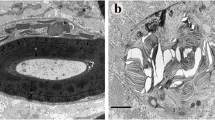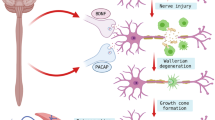Abstract
Aims/hypothesis
We sought to establish the molecular and pathological changes predisposing diabetic and non-diabetic patients to the development of carpal tunnel syndrome (CTS).
Methods
The posterior interosseous nerve (PIN) was biopsied in 25 diabetic and 19 non-diabetic patients undergoing carpal tunnel decompression for CTS. Detailed morphometric and immunohistological analyses were performed in the nerve biopsy.
Results
In diabetic patients median nerve distal motor latency was prolonged (p < 0.05 vs non-diabetic patients), PIN myelinated fibre density (p < 0.05), fibre area (p < 0.0001) and axon area (p < 0.0001) were reduced, the percentage of unassociated Schwann cell profiles (p < 0.0001) and unmyelinated axon density (p < 0.0001) were increased and the axon diameter was reduced (p < 0.0001). Endoneurial capillary basement membrane area was increased (p < 0.0001) in diabetic patients, but endothelial cell number was increased (p < 0.01) and luminal area was reduced (p < 0.05) in non-diabetic patients with CTS. There was no difference in the expression of hypoxia-inducible factor 1α between diabetic and non-diabetic patients with CTS. However, the expression of vascular endothelial growth factor A (VEGF) (p < 0.05) and its receptors VEGFR-1 (p < 0.01) and VEGFR-2 (p < 0.05) was significantly increased in diabetic patients, particularly those with type 1 diabetes, and related to the severity of nerve fibre pathology.
Conclusions/interpretation
This study demonstrates increased nerve fibre and microvascular pathology in relation to enhanced expression of VEGF and its receptors in a non-compressed nerve in diabetic compared with non-diabetic patients with CTS. It therefore provides a potential molecular and pathological basis for the predisposition of diabetic patients to the development of CTS.



Similar content being viewed by others
Abbreviations
- Ab:
-
Antibody
- CTS:
-
Carpal tunnel syndrome
- DCTS:
-
Diabetic patients with CTS
- DML:
-
Distal motor latency
- fSNCV:
-
Fractionated measurement of antidromic sensory conduction velocity
- HIF-1α:
-
Hypoxia-inducible factor 1α
- MNFD:
-
Myelinated nerve fibre density
- NCTS:
-
Non-diabetic patients with CTS
- PIN:
-
Posterior interosseus nerve
- USCP:
-
Unassociated Schwann cell profile
- VEGF:
-
Vascular endothelial growth factor
- VEGFR:
-
VEGF receptor
References
Bickel KD (2010) Carpal tunnel syndrome. J Hand Surg [Am] 35:147–152
de Krom MC, Knipschild PG, Kester AD, Thijs CT, Boekkooi PF, Spaans F (1992) Carpal tunnel syndrome: prevalence in the general population. J Clin Epidemiol 45:373–376
Atroshi I, Gummesson C, Johnsson R, Ornstein E, Ranstam J, Rosen I (1999) Prevalence of carpal tunnel syndrome in a general population. JAMA 282:153–158
Geoghegan JM, Clark DI, Bainbridge LC, Smith C, Hubbard R (2004) Risk factors in carpal tunnel syndrome. J Hand Surg (Br) 29:315–320
Burner TW, Rosenthal AK (2009) Diabetes and rheumatic diseases. Curr Opin Rheumatol 21:50–54
Kim RP, Edelman SV, Kim DD (2001) Musculoskeletal complications of diabetes mellitus. Clin Diabetes 19:132–135
Mesgarzadeh M, Schneck CD, Bonakdarpour A, Mitra A, Conaway D (1989) Carpal tunnel: MR imaging. Part II. Carpal tunnel syndrome. Radiology 171:749–754
Buchberger W, Judmaier W, Birbamer G, Lener M, Schmidauer C (1992) Carpal tunnel syndrome: diagnosis with high-resolution sonography. AJR Am J Roentgenol 159:793–798
Richard R (1999) Carpal tunnel syndrome and the myth of El Dorado. Muscle Nerve 22:1165–1167
Donato G, Galasso O, Valentino P et al (2009) Pathological findings in subsynovial connective tissue in idiopathic carpal tunnel syndrome. Clin Neuropathol 28:129–135
Hirata H, Nagakura T, Tsujii M, Morita A, Fujisawa K, Uchida A (2004) The relationship of VEGF and PGE2 expression to extracellular matrix remodelling of the tenosynovium in the carpal tunnel syndrome. J Pathol 204:605–612
Ferrara N (2004) Vascular endothelial growth factor: basic science and clinical progress. Endocr Rev 25:581–611
Bates DO, Harper SJ (2002) Regulation of vascular permeability by vascular endothelial growth factors. Vasc Pharmacol 39:225–237
Pugh CW, Ratcliffe PJ (2003) Regulation of angiogenesis by hypoxia: role of the HIF system. Nat Med 9:677–684
Gerber HP, Condorelli F, Park J, Ferrara N (1997) Differential transcriptional regulation of the two vascular endothelial growth factor receptor genes. Flt-1, but not Flk-1/KDR, is up-regulated by hypoxia. J Biol Chem 272:23659–23667
Kim WK, Kwon SH, Lee SH, Sunwoo IN (2000) Asymptomatic electrophysiologic carpal tunnel syndrome in diabetics: entrapment or polyneuropathy. Yonsei Med J 41:123–127
Dahlin LB, Meiri KF, McLean WG, Rydevik B, Sjostrand J (1986) Effects of nerve compression on fast axonal transport in streptozotocin-induced diabetes mellitus. An experimental study in the sciatic nerve of rats. Diabetologia 29:181–185
Thomsen NO, Mojaddidi M, Malik RA, Dahlin LB (2009) Reduced myelinated nerve fibre and endoneurial capillary densities in the forearm of diabetic and non-diabetic patients with carpal tunnel syndrome. Acta Neuropathol 118:785–791
Low PA (1987) Recent advances in the pathogenesis of diabetic neuropathy. Muscle Nerve 10:121–128
Cameron NE, Mathias CJ (2003) Structure and function of the nervous system. In: Gries FA, Cameron NE, Low PA, Ziegler D (eds) Textbook of diabetic neuropathy. Thieme, Stuttgart, Germany, p 50
Thomsen NO, Mojaddidi M, Malik RA, Dahlin LB (2009) Biopsy of the posterior interosseous nerve: a low morbidity method for assessment of peripheral nerve disorders. Diabet Med 26:100–104
Thomsen NO, Cederlund R, Bjork J, Dahlin LB (2010) Health-related quality of life in diabetic patients with carpal tunnel syndrome. Diabet Med 27:466–472
Rosen I (1993) Neurophysiological diagnosis of the carpal tunnel syndrome: evaluation of neurographic techniques. Scand J Plast Reconstr Surg Hand Surg 27:95–101
Malik RA, Veves A, Walker D et al (2001) Sural nerve fibre pathology in diabetic patients with mild neuropathy: relationship to pain, quantitative sensory testing and peripheral nerve electrophysiology. Acta Neuropathol 101:367–374
Quattrini C, Jeziorska M, Boulton AJ, Malik RA (2008) Reduced vascular endothelial growth factor expression and intra-epidermal nerve fiber loss in human diabetic neuropathy. Diabetes Care 31:140–145
Malik RA, Tesfaye S, Newrick PG et al (2005) Sural nerve pathology in diabetic patients with minimal but progressive neuropathy. Diabetologia 48:578–585
Ochoa J (1978) Recognition of unmyelinated fiber disease: morphologic criteria. Muscle Nerve 1:375–387
Jacobs JM, Love S (1985) Qualitative and quantitative morphology of human sural nerve at different ages. Brain 108:897–924
Chammas M, Bousquet P, Renard E, Poirier J-L, Jaffiol C, Allieu Y (1995) Dupuytren’s disease, carpal tunnel syndrome, trigger finger, and diabetes mellitus. J Hand Surg [Am] 20:109–114
Schmid AB, Elliott JM, Strudwick MW, Little M, Coppieters MW (2012) Effect of splinting and exercise on intraneural edema of the median nerve in carpal tunnel syndrome–an MRI study to reveal therapeutic mechanisms. J Orthop Res 30:1343–1350
Wirostko B, Wong TY, Simo R (2008) Vascular endothelial growth factor and diabetic complications. Prog Retin Eye Res 27:608–621
Carmeliet P, Storkebaum E (2002) Vascular and neuronal effects of VEGF in the nervous system: implications for neurological disorders. Semin Cell Dev Biol 13:39–53
Rydevik B, Lundborg G (1977) Permeability of intraneural microvessels and perineurium following acute, graded experimental nerve compression. Scand J Plast Reconstr Surg 11:179–187
Wilting J, Birkenhäger R, Eichmann A et al (1996) VEGF121 Induces proliferation of vascular endothelial cells and expression of flk-1 without affecting lymphatic vessels of the chorioallantoic membrane. Dev Biol 176:76–85
Barleon B, Siemeister G, Martiny-Baron G, Weindel K, Herzog C, Marme D (1997) Vascular endothelial growth factor up-regulates its receptor fms-like tyrosine kinase 1 (FLT-1) and a soluble variant of FLT-1 in human vascular endothelial cells. Cancer Res 57:5421–5425
Minchenko A, Bauer T, Salceda S, Caro J (1994) Hypoxic stimulation of vascular endothelial growth factor expression in vitro and in vivo. Lab Invest 71:374–379
Hoshi S, Nomoto K, Kuromitsu J, Tomari S, Nagata M (2002) High glucose induced VEGF expression via PKC and ERK in glomerular podocytes. Biochem Biophys Res Commun 290:177–184
Chiarelli F, Spagnoli A, Basciani F et al (2000) Vascular endothelial growth factor (VEGF) in children, adolescents and young adults with type 1 diabetes mellitus: relation to glycaemic control and microvascular complications. Diabet Med 17:650–656
Okamoto T, Yamagishi S, Inagaki Y et al (2002) Angiogenesis induced by advanced glycation end products and its prevention by cerivastatin. FASEB J 16:1928–1930
Hart AM, Wiberg M (2001) Nerve compression or mechanical neuropathy: neuropathology. Curr Orthop 15:245–248
Ozkul Y, Sabuncu T, Kocabey Y, Nazligul Y (2002) Outcomes of carpal tunnel release in diabetic and non-diabetic patients. Acta Neurol Scand 106:168–172
Wilbourn A (1999) Diabetic entrapment and compression neuropathies. In: Dyck P, Thomas P (eds) Diabetic neuropathy. WB Saunders, Philadelphia, pp 481–508
Sugimoto K, Shoji M, Yasujima M, Suda T, Yagihashi S (2004) Peripheral nerve endoneurial microangiopathy and necrosis in rats with insulinoma. Acta Neuropathol 108:503–514
Powell HC, Rosoff J, Myers RR (1985) Microangiopathy in human diabetic neuropathy. Acta Neuropathol 68:295–305
Malik RA, Newrick PG, Sharma AK et al (1989) Microangiopathy in human diabetic neuropathy: relationship between capillary abnormalities and the severity of neuropathy. Diabetologia 32:92–102
Renard E, Jacques D, Chammas M et al (1994) Increased prevalence of soft tissue hand lesions in type 1 and type 2 diabetes mellitus: various entities and associated significance. Diabete Metab 20:513–521
Cagliero E, Apruzzese W, Perlmutter GS, Nathan DM (2002) Musculoskeletal disorders of the hand and shoulder in patients with diabetes mellitus. Am J Med 112:487–490
Dyck PJ, Kratz KM, Karnes JL et al (1993) The prevalence by staged severity of various types of diabetic neuropathy, retinopathy, and nephropathy in a population-based cohort: the Rochester Diabetic Neuropathy Study. Neurology 43:817–824
Henricsson M, Nilsson A, Groop L, Heijl A, Janzon L (1996) Prevalence of diabetic retinopathy in relation to age at onset of the diabetes, treatment, duration and glycemic control. Acta Ophthalmol Scand 74:523–527
Kinnunen K, Puustjärvi T, Teräsvirta M et al (2009) Differences in retinal neovascular tissue and vitreous humour in patients with type 1 and type 2 diabetes. Br J Ophthalmol 93:1109–1115
Acknowledgements
The study was supported by the Swedish Research Council (Medicine; No. 5188), the Medical Faculty, Lund, Diabetesföreningen i Malmö med omnejd, Skåne University Hospital, Malmö and Region Skåne (ALF).
Duality of interest
The authors declare that there is no duality of interest associated with this manuscript.
Contribution statement
MAM, MA, RA, MJ and AA made substantial contributions to the acquisition, analysis and interpretation of data and drafted the article. NOBT and LBD made substantial contributions to the conception and design of the study and the acquisition, analysis and interpretation of data and revised the article critically for important intellectual content. RAM made substantial contributions to the conception and design of the study, analysis and interpretation of data and drafting and revising the article critically for important intellectual content. All authors gave final approval for the version to be published. RAM is the guarantor of this work.
Author information
Authors and Affiliations
Corresponding author
Rights and permissions
About this article
Cite this article
Mojaddidi, M.A., Ahmed, M.S., Ali, R. et al. Molecular and pathological studies in the posterior interosseous nerve of diabetic and non-diabetic patients with carpal tunnel syndrome. Diabetologia 57, 1711–1719 (2014). https://doi.org/10.1007/s00125-014-3271-3
Received:
Accepted:
Published:
Issue Date:
DOI: https://doi.org/10.1007/s00125-014-3271-3




